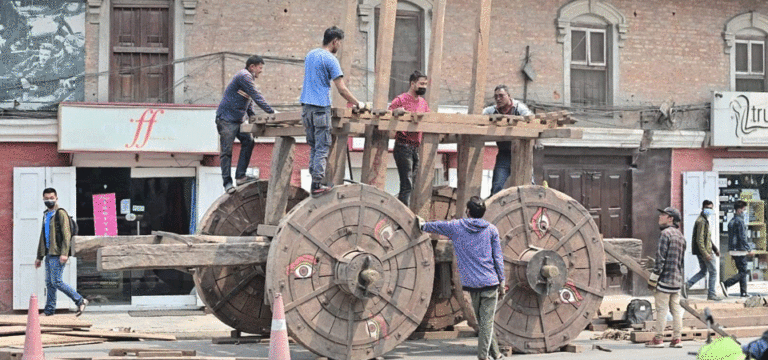
Guthi Sansthan of Kathmandu has begun works to construct the chariot of Seto Machhindranath at Tindhara Pathshala, Jamal.
This year, the white Machhindranath festival falls on April 20.
The Seto Machhindranath Rathyatra Management Committee has already decided to give continuity to the traditional festival of chariot procession despite the growing cases of COVID-19 in Kathmandu.
Last year, the chariot procession was put off because of lockdown and the fear of COVID-19 pandemic.
Coordinator of the committee and chair of Kathmandu Ward No.25 Nilkaji Shakya said that preparations for the chariot procession had already begun.
The chariot of the White Machhindranath will be designed in a triangular shape as in the past.
Around 365 pieces of timber are used to make the chariot. Nine kinds of wood are required to build the chariot. But in lack of several kinds of wood, Sal timber is used to prepare 25 per cent structure of the chariot.
The entire structure of the chariot is modeled on the shape of a temple. The chariot is pulled with big ropes from left and right.
According to a legend, Machhendranath was the teacher of Gorakhatanath. The year in 595 AD saw the beginning of the festival of the White Machhindranath chariot procession. It is known as Janmadyo, Aryavalokiteswr, Karunamaya and Jamaleswor.
The Seto (White) Machhindranath is a widely venerated deity of the Kathmandu Valley.
The chariot-pulling of the deity is a three-day cultural festival.
During the festival, the chariot is taken to several parts of the city. The pulling of the chariot starts from Jamal and it is taken to Ratna Park, Bhotahiti and Asan. On the second day, it is taken to Balkumari, Keltole, Indrachowk, Makhan and Hanumandhoka and on the third and last day, it is pulled towards Chinkmugal from where it is taken to Jaishidewal, Janabahal and Lagan.
Normally, the festival is celebrated for three days, but it takes a week to move the chariot to different core areas of the ancient city.
Many people visit the chariot and offer their worship to the idol of the Machhindranath deity kept inside the chariot.
They perform religious activities for attaining prosperity in their life and fulfilling their inner desire. Hence every year, Nepalese celebrate chariot pulling festival.
It is widely believed that if the chariot festival is successfully concluded, there will be no draught and famine in the country that particular year.
Source : THE RISING NEPAL,






